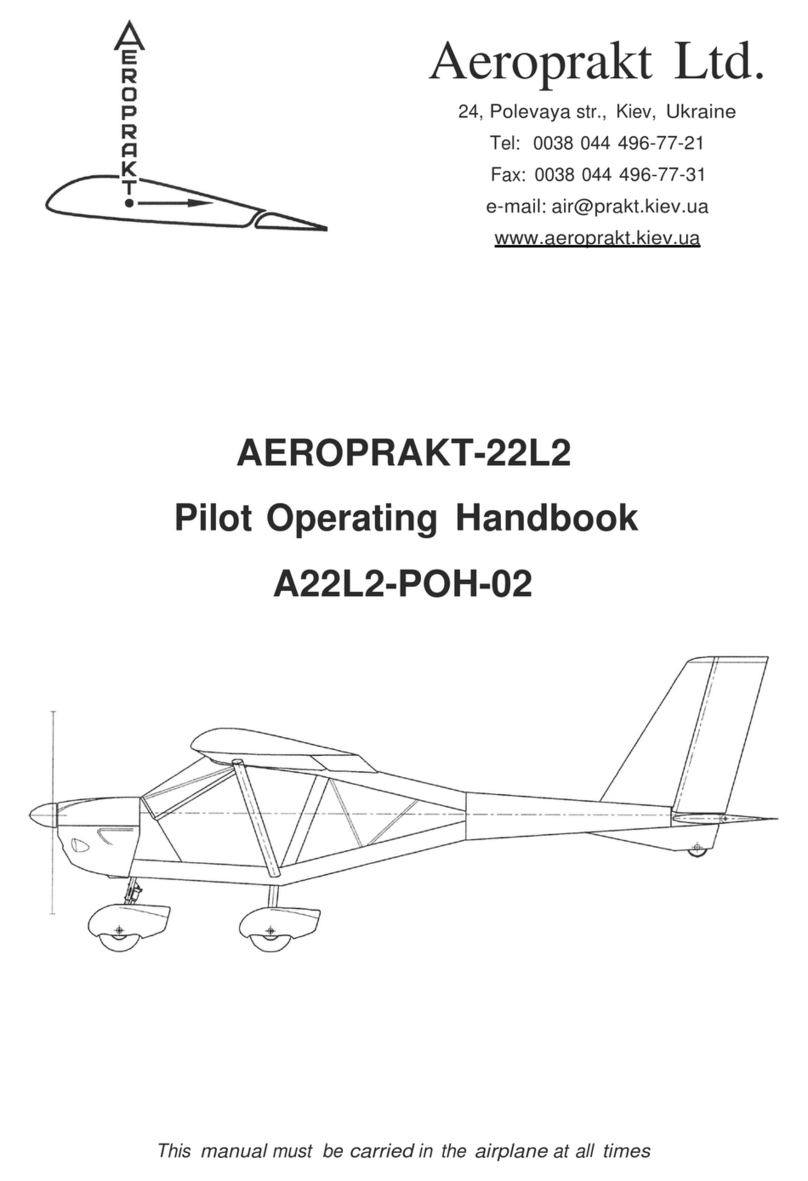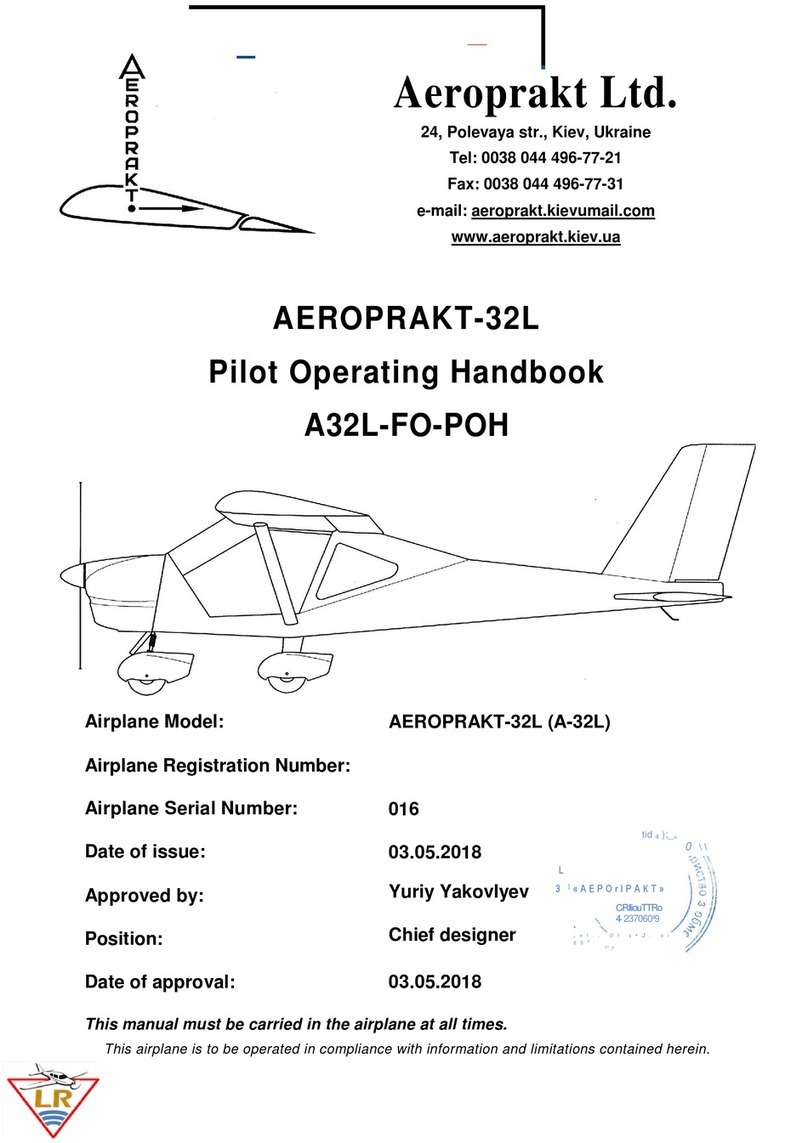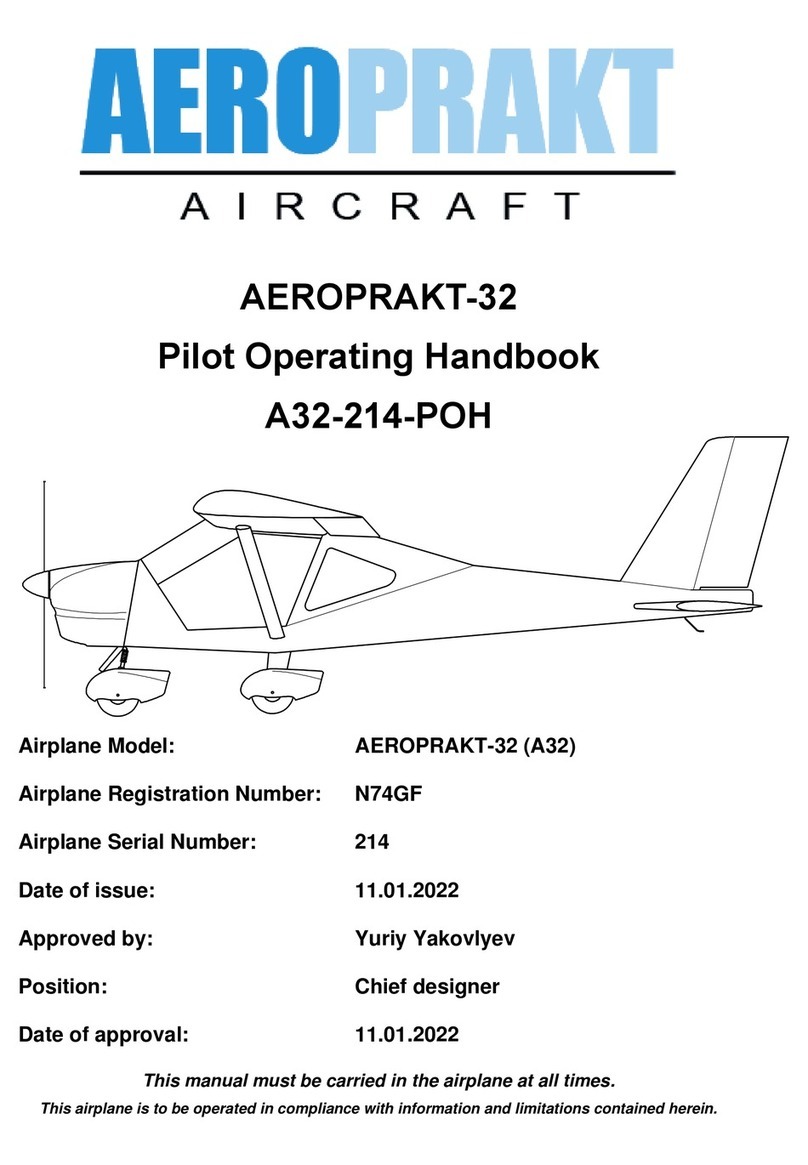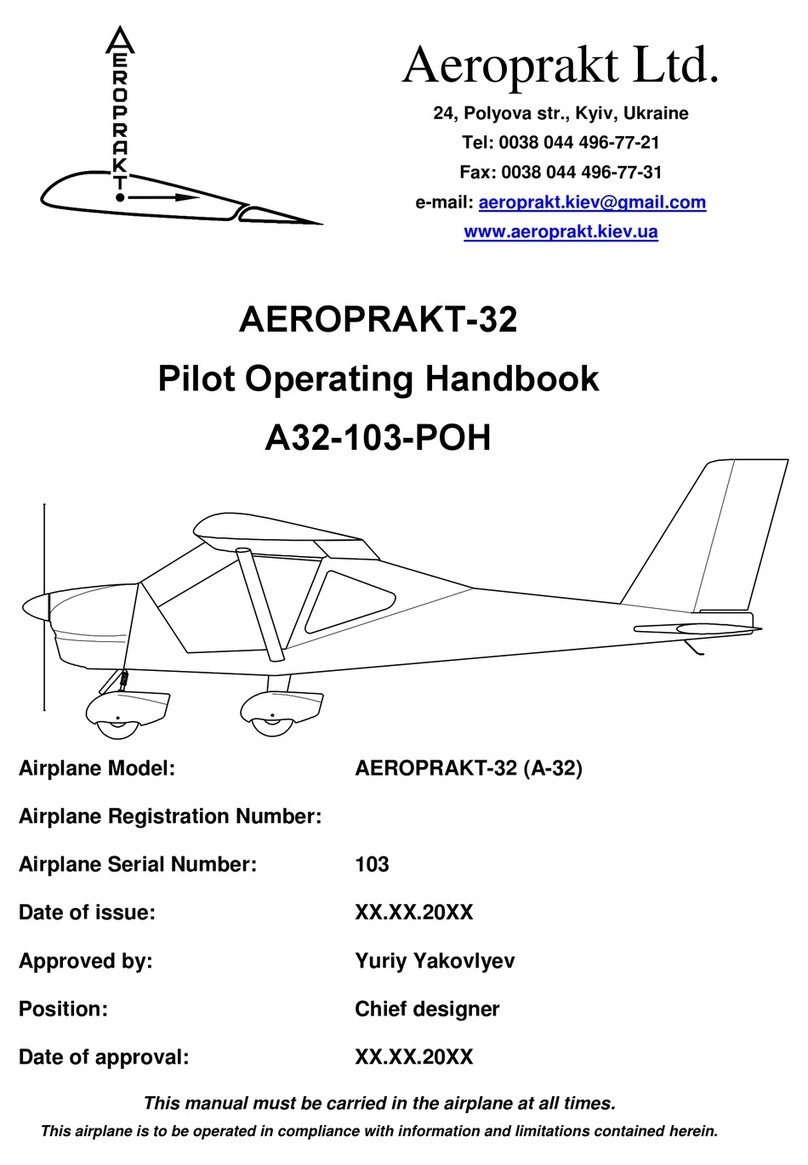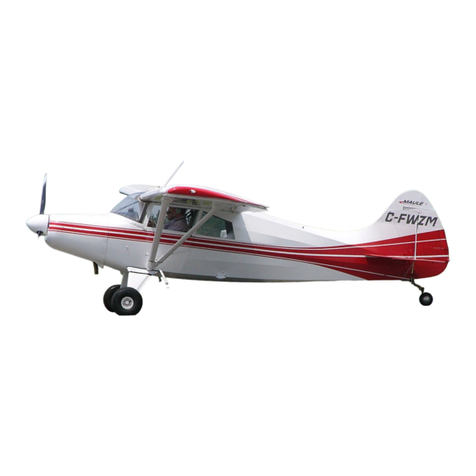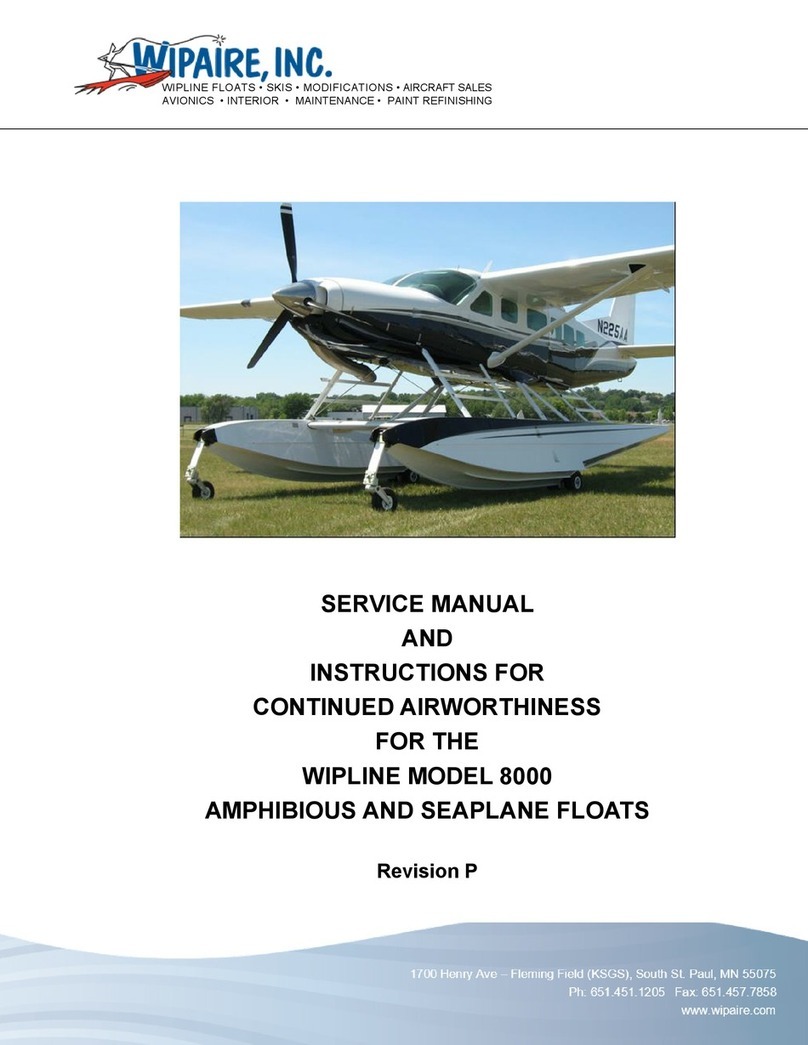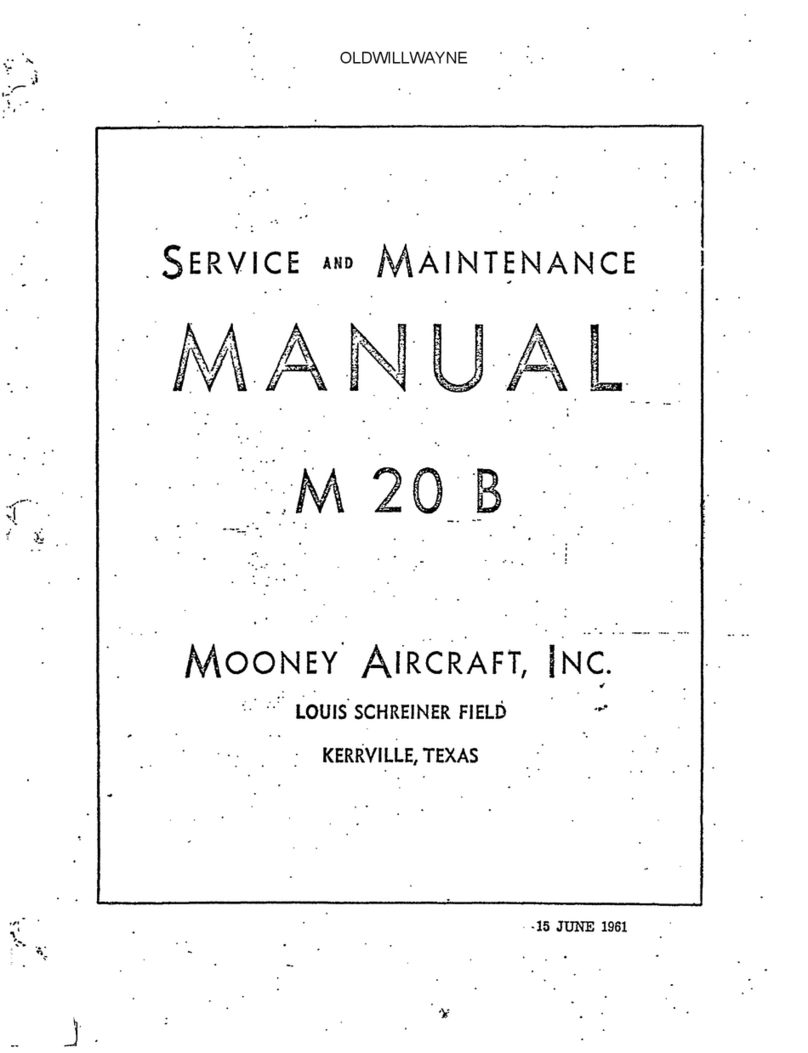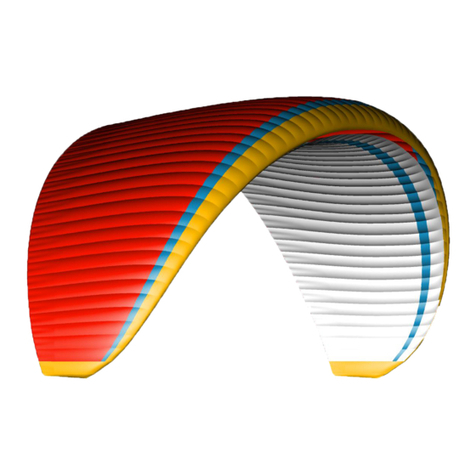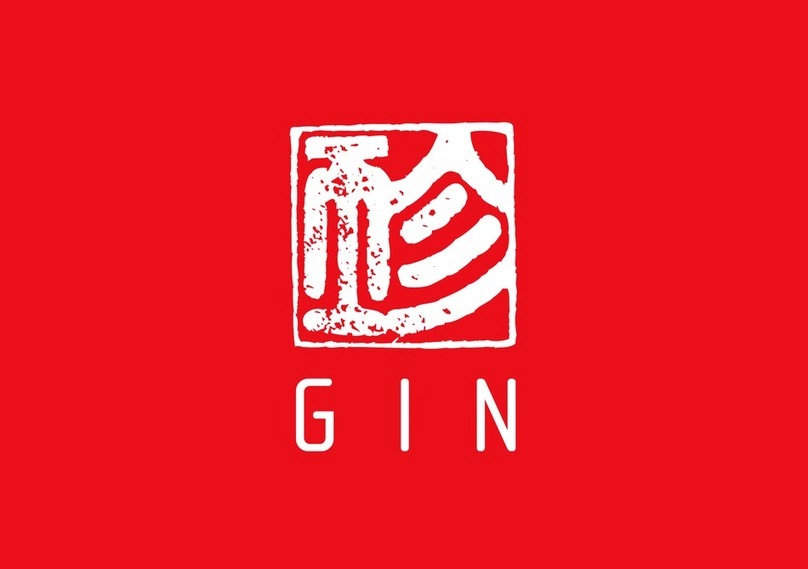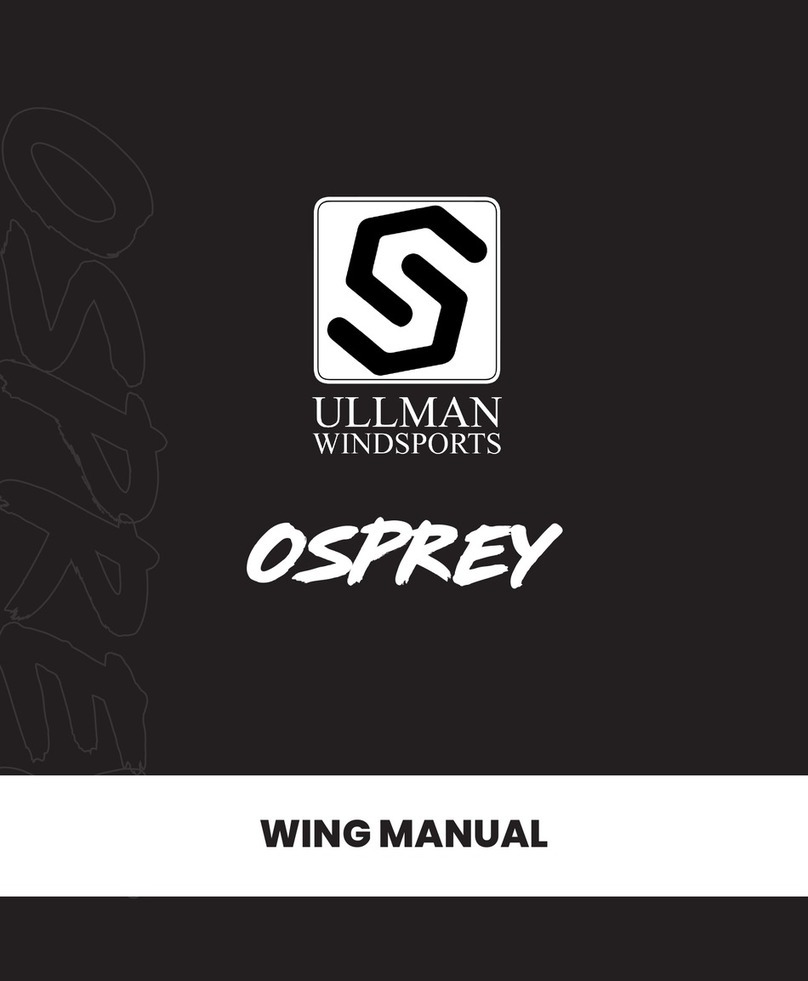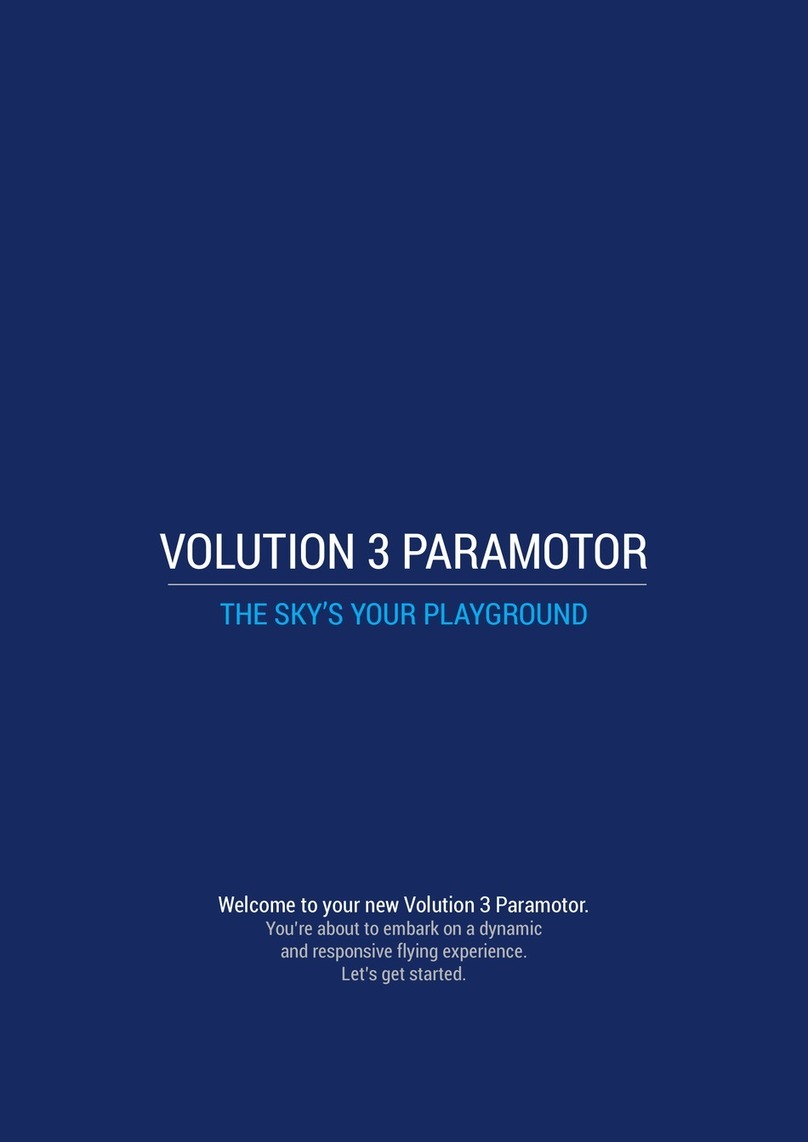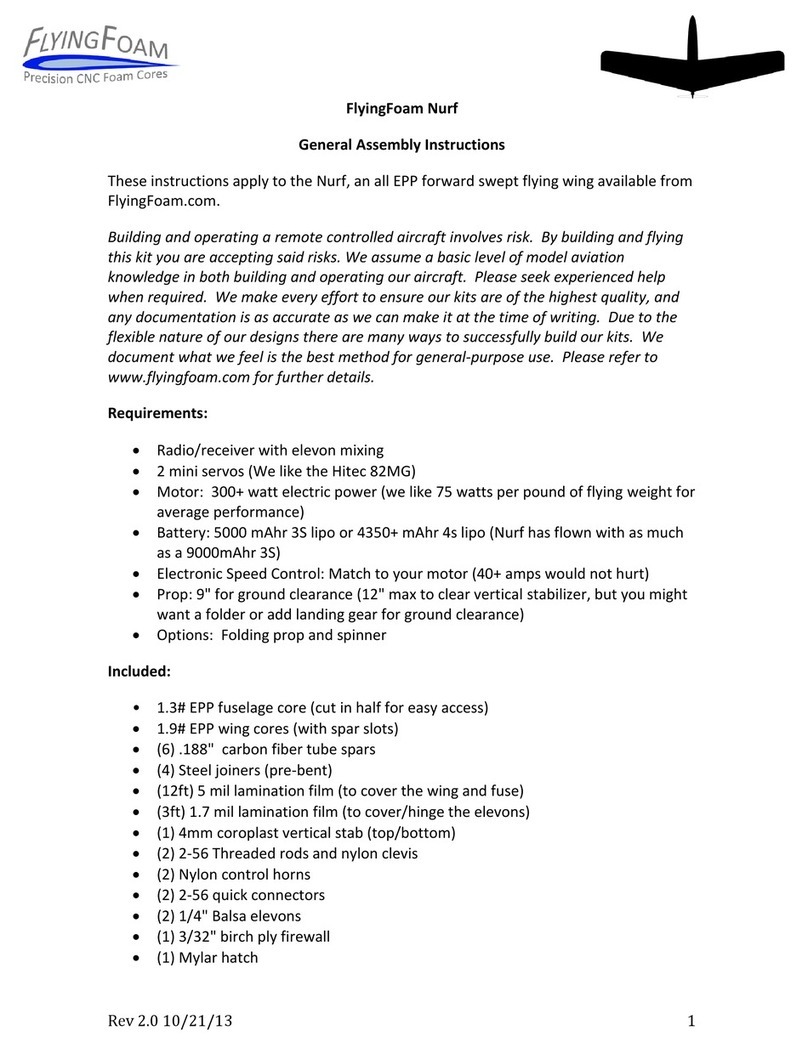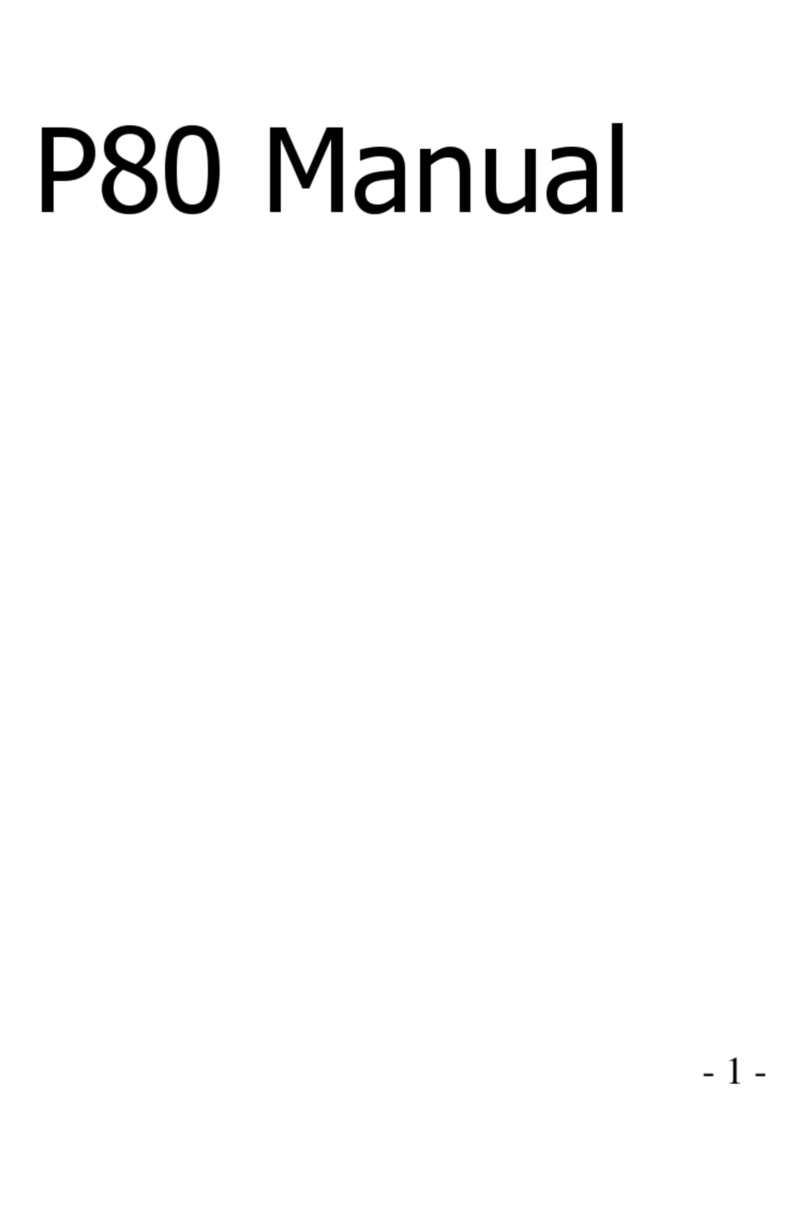AEROPRAKT AEROPRAKT-32 Owner's manual

Aeroprakt Ltd.
24, Polevaya str., Kiev, Ukraine
Tel: 0038 044 496-77-21
Fax: 0038 044 496-77-31
e-mail: [email protected].ua
www.aeroprakt.kiev.ua
AEROPRAKT-32
Pilot Operating Handbook
A32-002-POH
Airplane Model: AEROPRAKT-32 (A-32)
Airplane Registration Number:
Airplane Serial Number: 002
Date of issue: 07.04.2015
Approved by: Yuriy Yakovlyev
Position: Chief designer
Date of approval: 07.04.2015
This manual must be carried in the airplane at all times.
This airplane is to be operated in compliance with information and limitations contained herein.

AEROPRAKT-32 Pilot Operating Handbook A32-002-POH
2
RECORD OF MANUAL REVISIONS
No part of this manual may be reproduced or changed in any manner without a written
consent of the Manufacturer.
Any revision of the present manual, except actual weighing data, must be recorded in the
following table according to information from the Manufacturer.
New or amended text in the revised pages will be indicated by a black vertical line on the
left hand margin, and the Revision No. and the date will be shown on the bottom left hand
side of the page.
Rev. No.
Affected
Section
Affected
Pages
Date
Approval
Date
Date
Inserted
Signature

AEROPRAKT-32 Pilot Operating Handbook A32-002-POH
3
Table of contents
Introduction........................................................................................................................5
1General information .....................................................................................................6
1.1 General description of the airplane .........................................................................6
1.2 Airplane specifications ............................................................................................6
2Limitations ....................................................................................................................7
2.1 Airspeeds and Airspeed Indicator markings............................................................7
2.2 Service ceiling.........................................................................................................8
2.3 Maneuvering load factors........................................................................................8
2.4 Approved maneuvers..............................................................................................8
2.5 Fuel capacity and type ............................................................................................8
2.6 Engine.....................................................................................................................9
2.7 Kinds of operation limits..........................................................................................9
2.8 Crosswind limitation ................................................................................................9
3Emergency procedures..............................................................................................10
3.1 General .................................................................................................................10
3.2 Emergency checklists ...........................................................................................10
4Normal Procedures ....................................................................................................15
4.1 General .................................................................................................................15
4.2 Preflight check.......................................................................................................15
4.3 Engine starting......................................................................................................17
4.4 Taxiing...................................................................................................................18
4.5 Before takeoff........................................................................................................18
4.6 Normal takeoff.......................................................................................................18
4.7 Short/soft field takeoff ...........................................................................................19
4.8 Climb.....................................................................................................................19
4.9 Cruise....................................................................................................................19
4.10 Approach...............................................................................................................19
4.11 Normal landing......................................................................................................20
4.12 Short/soft field landing...........................................................................................20
4.13 Balked landing.......................................................................................................20
5Performance................................................................................................................21
5.1 General .................................................................................................................21
5.2 Takeoff and landing distances...............................................................................21
5.3 Climb performance................................................................................................21
5.4 Cruise speeds and fuel consumption at various RPM settings..............................21
6Weight and Balance and Equipment List .................................................................22
6.1 Weight and Balance Chart ....................................................................................22
6.2 Installed equipment list..........................................................................................23

AEROPRAKT-32 Pilot Operating Handbook A32-002-POH
4
7Airplane and Systems Descriptions .........................................................................24
7.1 General .................................................................................................................24
7.2 Airframe.................................................................................................................24
7.3 Landing gear.........................................................................................................24
7.4 Engine and its controls..........................................................................................25
7.5 Propeller................................................................................................................25
7.6 Fuel system...........................................................................................................26
7.7 Airplane control systems.......................................................................................28
7.8 Instrument panel ...................................................................................................36
7.9 Full and static pressure system.............................................................................38
7.10 Electrical system...................................................................................................39
7.11 Seats and harness belts........................................................................................44
7.12 Cockpit doors........................................................................................................44
7.13 Baggage compartment..........................................................................................44
7.14 Recovery system...................................................................................................44
8Aircraft Ground Handling and Servicing..................................................................46
8.1 Introduction ...........................................................................................................46
8.2 Towing, parking and tie-down instructions ............................................................46
8.3 Servicing fuel, oil and coolant................................................................................46
8.4 Approved fuel and oil ............................................................................................47
8.5 Cleaning and care.................................................................................................47
8.6 Disassembling and assembling the airplane.........................................................47
9Supplements...............................................................................................................51
9.1 General .................................................................................................................51
9.2 Engine manual......................................................................................................51
9.3 Avionics and special engine instruments ..............................................................51
9.4 Recovery system...................................................................................................51
9.5 Floats ....................................................................................................................51
9.6 List of installed equipment.....................................................................................52
9.7 Actual empty weight and CG position data............................................................53
9.8 Airplane Flight Training Supplement.....................................................................54
9.9 Airplane Owner Feedback to Manufacturer...........................................................57

AEROPRAKT-32 Pilot Operating Handbook A32-002-POH
5
Introduction
This Pilot Operating Handbook has been prepared to provide the airplane owner and
operators with information required for the safe and efficient operation of this airplane.
The following ASTM standards have been and/or shall be used for the design, construction
and continued airworthiness of this Aeroprakt-32 (A-32) airplane:
F2245-14 Standard Specification for Design and Performance of a Light Sport Airplane,
F2972-14 Standard Specification for Light Sport Aircraft Manufacturer’s Quality Assurance
System,
F2295-10 Standard Practice for Continued Operational Safety Monitoring of a Light Sport
Aircraft,
F2316-12 Standard Specification for Airframe Emergency Parachutes for Light Sport
Aircraft,
F2339-06 Standard Practice for Design and Manufacture of Reciprocating Spark Ignition
Engines for Light Sport Aircraft,
F2745-11 Standard Specification for Required Product Information to be Provided with an
Airplane
F2746-14 Standard Specification for Pilot's Operating Handbook (POH) for Light Sport
Airplane.
This A-32 airplane was manufactured by:
Aeroprakt Ltd.
24 Polyova str.
Kyiv, 03056
UKRAINE
Tel.: +380 44 496-77-21
Fax: +380 44 496-77-31
E-mail: [email protected]
www.aeroprakt.kiev.ua
Should the original manufacturer of the aircraft loose its ability to support this aircraft make
and model, contact:
Mr. Peter Harlow
Foxbat Australia
PO Box 237, Black Rock, Victoria 3193
AUSTRALIA
Tel./fax: +61 (0) 3 9592 3101
Mobile: +61 (0) 413 900 892
Email: [email protected]
www.foxbat.com.au

AEROPRAKT-32 Pilot Operating Handbook A32-002-POH
6
1 General information
1.1 General description of the airplane
AEROPRAKT-32 (A-32) is a two-seat, high-wing strut braced monoplane of "classic"
aerodynamic layout with closed cockpit, non-retractable landing gear with steerable nose
wheel, Rotax-912 engine with tractor three-blade on-ground adjustable pitch propeller.
AEROPRAKT-32 is approved for flying in VFR, simple meteorological conditions.
AEROPRAKT-32 is certified in the LSA (Light Sport Airplane) category.
1.2 Airplane specifications
Specification
US units
Metric
Wing span
31 ft
9.45 m
Wing area
138 sq ft
12.83 m²
Length
20 ft 7 in
6.27 m
Height
7 ft 3 in
2.22 m
Wheel base
4 ft 2 in
1.27 m
Wheel track
5 ft 9 in
1.75 m
Gross weight (Maximum Take-Off Weight, MTOW)
1320 lb
600 kg
Top speed at sea level, ISA conditions
116 kts
215 km/h
Cruising speed (IAS) at 1000 ft, ISA conditions, engine RPM:
3500
54 kts
100 km/h
3800
67 kts
125 km/h
4200
81 kts
150 km/h
4650
94 kts
175 km/h
5150
108 kts
200 km/h
5500
116 kts
215 km/h
Range with full tanks (30 min. reserve) at 1000 ft, still air,
ISA conditions, 3700 RPM
706 nm
1307 km
Best angle of climb speed (VX), IAS
54 kts
100 km/h
Best rate of climb speed (VY), IAS
65 kts
120 km/h
Stalling speed at MTOW, flaps up (VS), IAS
32 kts
60 km/h
Stalling speed at MTOW, full flaps (VS0), IAS
27 kts
50 km/h
Maximum engine power at 5800 RPM (5 minutes limit)
100 hp
73.5 kW
Total fuel capacity
23.8 US gal
90 l
Usable fuel
23.6 US gal
89.5 l
Approved fuel types: unleaded mogas min. RON 95 or avgas 100LL

AEROPRAKT-32 Pilot Operating Handbook A32-002-POH
7
2 Limitations
2.1 Airspeeds and Airspeed Indicator markings
Airspeed limitations and corresponding IAS values are given in the table below.
Scheme of color markings of airspeed indicator is shown on Fig. 1. Its explanation is given
in the table below.
Marking
IAS value or
range, km/h (kts)
Airspeed (range) symbol(s) and description
White arc start
50 (27)
VS0 –stalling speed at maximum takeoff weight
with full flaps
Green arc start
60 (32)
VS–stalling speed at maximum takeoff weight
with flaps up
White arc
50 - 145 (27 - 79)
VS0 to VFE –flap extended speed range
Green arc
60 - 195 (32 - 105)
VSto VO–normal operating speed range
Green and
Yellow arcs
border
195 (105)
VO–operating maneuvering speed at gross
weight and minimum weight
Yellow arc
195 - 230
(105 - 124)
VOto VNE –in this range maneuvers must be
conducted with caution and only in smooth air
Red line
230 (124)
VNE –never-exceed speed, maximum speed for all
operations
Fig. 1 Airspeed Indicator markings

AEROPRAKT-32 Pilot Operating Handbook A32-002-POH
8
2.2 Service ceiling
Service ceiling of A-32 with Rotax-912ULS (100 hp) engine is equal to at least 5000 m
(16 000 ft).
However A-32 has neither pressurized cockpit nor oxygen equipment and therefore may
not be used for high-altitude flight.
2.3 Maneuvering load factors
Limit load factors for the airplane at gross weight of 650 kg (1430 lb) are as follows:
Maximum positive limit load factor +4.0
Maximum negative limit load factor -2.0
2.4 Approved maneuvers
A-32 airplane belongs to a non-aerobatic category. All maneuvers shall be done within its
airspeed and maneuvering load factor limits (G limits). Approved maneuvers include:
- turns with bank angles up to 60°,
- side-slipping with angles up to 15°,
- level and accelerated stalls without spinning,
- diving at a speed below VNE of 230 km/h (124 kts) IAS.
Any aerobatics including intentional spinning is prohibited!
2.5 Fuel capacity and type
Standard
Optional
Capacity of tanks:
2×45 l (11.9 US gal)
2×57 l (2×15.05 US gal)
Total fuel capacity:
90 l (23.8 US gal)
114 l (30.1 US gal)
Total usable fuel:
89.5 l (23.6 US gal)
113.5 l (30.0 US gal)
Non-usable fuel:
0.5 l (0.13 US gal)
0.5 l (0.13 US gal)
Approved fuel types: unleaded mogas min. RON 95 or avgas 100LL.

AEROPRAKT-32 Pilot Operating Handbook A32-002-POH
9
2.6 Engine
Engine data and operational limitations are given in the table below:
Engine manufacturer:
BOMBARDIER-Rotax-GmbH (Austria)
Engine model:
Rotax-912ULS
Maximum takeoff power:
100 h.p.
Time limit at full power:
5 min (5800 rpm)
Max. revolutions (no time limit)
5500 rpm
Min. revolutions at idle
1400 rpm
Maximum cylinder head
temperature at pick-up point:
135°C (284°F)
Oil temperature, normal
minimum
maximum
90-110°C (190-250°F)
50°C (120°F)
130°C (266°F)
Exhaust gas temperature:
- maximum at takeoff
- maximum
- normal
880°C (1620°F)
850°C (1560°F)
800°C (1470°F)
Oil pressure, normal
minimum
maximum
2.0-5.0 bar (29-73 psi) (above 3500 RPM)
0.8 bar (12 psi) (below 3500 RPM)
7 bar (100 psi) (at cold start, allowed for a short time)
Fuel pressure, normal
maximum
0.15-0.4 bar (2.2-5.8 psi)
0.4 bar (5.8 psi)
Fuel:
unleaded mogas min. RON 95 or avgas 100LL
Oil:
any automotive oil of API classification “SG” or higher
Ambient air temperature range
from -25°C (-13°F) to +50°C (+122°F)
NOTE: On all issues of engine operation see Rotax engine Operator's Manual.
Follow its instructions to ensure safe and efficient operation of the engine.
2.7 Kinds of operation limits
This aircraft is approved for flying day and night, VFR, simple meteorological conditions.
Flight into icing conditions is prohibited.
2.8 Crosswind limitation
Maximum crosswind component for A-32 airplane is 7 m/s (14 kts).
It is highly recommended to choose upwind direction for takeoff and landing with the least
crosswind. It will significantly shorten takeoff and landing distances and increase degree of
safety.

AEROPRAKT-32 Pilot Operating Handbook A32-002-POH
10
3 Emergency procedures
3.1 General
This section contains recommendations to the pilots in case of emergency in flight.
However such situations, caused by airframe or engine malfunction are extremely rare
provided that pre-flight inspections and checks are performed regularly.
3.2 Emergency checklists
3.2.1 Engine fire during start
1. Throttle –IDLE
2. Ignition –OFF.
3. Fuel valves –CLOSE.
4. Unfasten seat belts, abandon cockpit.
5. Take measures to extinguish the fire.
3.2.2 Engine failure during takeoff
3.2.2.1 during takeoff roll
1. Throttle –IDLE.
2. Ignition –OFF.
3. Brakes –APPLY as necessary.
3.2.2.2 immediately after takeoff
1. Direction –NO TURN BACK.
2. Airspeed –110 km/h (59 kts) –best glide.
3. Throttle –IDLE.
4. Ignition –OFF.
5. Master switch –OFF.
6. Fuel valves –CLOSE.
7. Landing –STRAIGHT AHEAD, avoid colliding with obstacles.
3.2.3 Loss of engine power in flight
3.2.3.1 during climb
1. Airspeed –110 km/h (59 kts) –best glide.
2. Throttle –IDLE.
3. Ignition –OFF.
4. Fuel valves –CLOSE.
5. Direction –TURN to the airfield (if altitude permits).
6. Landing –STRAIGHT AHEAD, avoid colliding with obstacles.

AEROPRAKT-32 Pilot Operating Handbook A32-002-POH
11
3.2.3.2 in level flight
1. Airspeed –110 km/h (59 kts) –best glide.
2. Landing area –SELECT (consider altitude and wind).
3. Engine –RESTART (if time and altitude permit), see section 3.2.4.
4. Unable to restart –follow emergency landing procedure, see section 3.2.5.
3.2.4 Restarting engine in flight
1. Throttle –IDLE.
2. Fuel valves –check OPEN.
3. Fuel level –CHECK.
4. Ignition –ON.
5. Master key –turn to START.
3.2.5 Emergency landing without engine power
1. Airspeed –110 km/h (59 kts) –best glide.
2. Flaps –position 1.
3. Ignition –OFF.
4. Fuel valves –CLOSE.
5. Landing area –SELECT, consider altitude and wind. (No place suitable for landing –use
recovery system.)
6. Emergency call –TRANSMIT (121.5 MHz or nearest airfield frequency).
7. Flaps –EXTEND FULLY on final.
8. Landing –in the SELECTED place, avoid colliding with obstacles.
9. Touchdown –at minimum speed.
3.2.6 Precautionary landing with engine power
(In case of decision to discontinue the flight with engine running)
1. Airspeed –SELECT SAFE for the particular situation.
2. Throttle –SET to maintain selected airspeed.
3. Fuel –CHECK level and valves.
4. Map –CHECK for nearest airfields/area suitable for landing.
5. Landing area –SELECT.
6. Radio –REPORT decision to land on the selected place if necessary.
7. Landing –follow NORMAL or SHORT-FIELD landing procedure as appropriate.

AEROPRAKT-32 Pilot Operating Handbook A32-002-POH
12
3.2.7 Fire in flight
1. Ignition –OFF.
2. Fuel valves –CLOSE.
3. Yoke –PUSH to descend.
4. Airspeed –BELOW 230 km/h (124 kts).
5. Landing area –SELECT (consider altitude and wind).
6. Landing –in the SELECTED place, avoid colliding with obstacles.
7. Unfasten seat belts, abandon cockpit.
8. Take measures to extinguish the fire.
3.2.8 Loss of oil pressure
1. Follow PRECAUTIONARY LANDING procedure, see section 3.2.6.
2. Engine overheating or stopped –follow EMERGENCY LANDING procedure, see section
3.2.5.
3.2.9 High oil pressure
1. Throttle –REDUCE rpm, IDLE if necessary.
2. Airspeed –110 km/h (59 kts) –best glide.
3. Oil pressure –CONTROL.
4. Oil pressure normal –follow PRECAUTIONARY LANDING procedure, see section 3.2.6.
5. Oil pressure high –follow EMERGENCY LANDING procedure, see section 3.2.5.
3.2.10 Emergency descent
1. Yoke –PUSH to descend.
2. Throttle –IDLE.
3. Airspeed –BELOW 230 km/h (124 kts).
4. Engine speed –BELOW 5800 rpm.
5. Air traffic –CONTROL to avoid collisions.
6. Altitude –CONTROL.
7. Terrain –CONTROL.
8. At safe altitude –PULL YOKE GENTLY to level off.
9. G loads –DO NOT EXCEED +4g.
3.2.11 Alternator failure
Follow PRECAUTIONARY LANDING procedure, see section 3.2.6.
3.2.12 Overvoltage
1. Additional electrical consumers (landing light, strobes, etc.) –switch ON.
2. Voltage –CHECK.
3. Voltage normal –CONTINUE normal flight.
4. Voltage high –REMOVE battery charge fuse and FOLLOW PRECAUTIONARY
LANDING procedure, see section 3.2.6.

AEROPRAKT-32 Pilot Operating Handbook A32-002-POH
13
3.2.13 Inadvertent spin
1. Rudder pedals –FULLY AGAINST ROTATION.
2. Yoke –PUSH to stops.
3. Rotation stopped –rudder pedals NEUTRAL.
4. Speed reached 110 km/h (59 kts) –PULL YOKE GENTLY to recover from diving.
Do not exceed +4g and 230 km/h (124 kts)!
WARNING: Intentional spinning in A-32 is prohibited!
NOTE: In level flight and during turn stall warning is assured by the aerodynamic
characteristics of A-32 –gentle shaking of the airplane and yoke due to the
starting airflow separation.
3.2.14 Inadvertent icing encounter
1. Abandon icing build-up area.
2. Icing build-up not stopped –FOLLOW PRECAUTIONARY LANDING procedure, see
section 3.2.6.
3.2.15 Loss of primary instruments
3.2.15.1 ASI failure due to full pressure line blockage
Signs of the blockage –airspeed indicator reading either:
- does not change with changing airspeed in level flight or,
- reduces during a steady descent or,
- increases during a steady climb.
1. Airspeed indicator readings –IGNORE.
2. In level flight –SET THROTTLE to 4000-4500 rpm.
3. Altitude –MAINTAIN.
4. In descent –SET THROTTLE to IDLE.
5. Sink rate –SET to 3 m/s (600 ft/min).
6. Follow PRECAUTIONARY LANDING procedure, see section 3.2.6.
3.2.15.2 Altimeter, VSI and ASI failure due to static pressure line blockage
Signs of the blockage:
- altimeter and vertical speed indicator readings do not change with changing altitude or,
- airspeed indicator reading increases during a steady descent or,
- airspeed indicator reading reduces during a steady climb.
1. IGNORE altimeter, VSI and ASI readings.
2. Airplane attitude –CONTROL by the position of the horizon line with relation to the
wings and engine cowling.
3. Airspeed and vertical speed –CONTROL using throttle.
4. Follow PRECAUTIONARY LANDING procedure, see section 3.2.6.

AEROPRAKT-32 Pilot Operating Handbook A32-002-POH
14
3.2.15.3 Powerplant instruments failure
(Tachometer, oil, water and exhaust temperature indicators, fuel quantity indicator)
1. IGNORE powerplant instruments readings.
2. Engine rpm –CONTROL by engine noise.
3. Follow PRECAUTIONARY LANDING procedure, see section 3.2.6.
3.2.16 Loss of flight controls
1. Elevator control fails –use elevator TRIM TAB control.
2. Rudder control fails –use AILERONS to control direction.
3. Aileron control fails –use RUDDER to control bank.

AEROPRAKT-32 Pilot Operating Handbook A32-002-POH
15
4 Normal Procedures
4.1 General
This section describes normal procedures recommended for safe operation of the A-32.
4.2 Preflight check
Pilots must inspect the general condition of the airplane during its preflight check. The
airplane must have no damage or maladjustments that may be critical for the flight safety.
The cockpit glass, propeller, wing and empennage must be clean of rainwater, snow, frost,
ice, and dirt as they impair visibility and aerodynamics and increase weight.
Preflight check must be performed according to the following order and requirements:
4.2.1 Entire airplane
1. Covers and clamps –REMOVED.
2. Airplane –CLEAN of rainwater, snow, frost, ice and dirt.
3. Rigging –CHECK visually.
4. External damage –NONE.
4.2.2 Power plant
1. Propeller and spinner –CLEAN, INTACT and SECURE.
2. Top cowling –REMOVE for engine inspection.
3. Oil, coolant and braking fluid –CHECK level.
4. Engine mount and vibration dampers –NO CRACKS and INTACT.
5. Cables and hoses –INTACT and SECURE.
6. Fuel, oil, coolant leaks –NONE.
7. Exhaust system, its attachments, joints and springs –NO CRACKS and INTACT.
8. Top cowling –INSTALL back.
9. Cowling and its locks –INTACT and LOCKED.
4.2.3 Landing gear
1. Wheel fairings –CLEAN, INTACT and SECURE.
2. Wheel pressure –OK.
3. Tires –NO CRACKS, WEAR OK.
4. Main wheel brakes –CLEAN, INTACT and SECURE.
5. Braking fluid –NO LEAKS.
6. Nose and main legs –NO CRACK and INTACT.
7. Nose leg shock absorber –INTACT.

AEROPRAKT-32 Pilot Operating Handbook A32-002-POH
16
4.2.4 Right wing
1. Wing and strut surface –CLEAN and INTACT.
2. Wing and strut attachment fittings and bolts –IN PLACE, INTACT and SECURE.
3. Wing fuel tank cap –IN PLACE and SECURE.
4. Fuel leaks –NONE.
5. Fuel tank vent outlet –CLEAN and INTACT.
6. Wing tip and navigation/strobe light –INTACT.
7. Flaperon clamp –REMOVED.
8. Flaperon –CLEAN and INTACT.
9. Flaperon hinge brackets –INTACT, BOLTS SECURE, HINGES GREASED.
10.Flaperon control linkage attachment –INTACT and SECURE.
4.2.5 Right side of fuselage
1. Fuselage surface –CLEAN and INTACT.
2. Cockpit glass –CLEAN, INTACT and NO CRACKS.
3. Door hinges and lock –INTACT.
4. Recovery system condition –CHECK visually.
5. Drain valve –CLOSED, NO FUEL LEAKS.
6. Fuel residue –DRAIN and CHECK.
4.2.6 Empennage
1. Empennage surface –CLEAN and INTACT.
2. Clamps/stops –REMOVED.
3. Horizontal stabilizer attachment fittings and bolts –INTACT and SECURE.
4. Rudder, elevator and trim tab –CLEAN and INTACT.
5. Rudder, elevator and trim tab hinge brackets –INTACT, SECURE and GREASED.
6. Rudder, elevator and trim tab control linkage attachment –INTACT and SECURE.
4.2.7 Left side of fuselage
1. Fuselage surface –CLEAN and INTACT.
2. Cockpit glass –CLEAN, INTACT and NO CRACKS.
3. Door hinges and lock –INTACT.
4. Battery and power cables' attachment –SECURE, CONDITION OK.
5. Control system linkages inside the rear fuselage –CHECK visually.
6. Baggage container condition –CHECK visually.

AEROPRAKT-32 Pilot Operating Handbook A32-002-POH
17
4.2.8 Left wing
1. Flaperon control linkage attachment –INTACT and SECURE.
2. Flaperon hinge brackets –INTACT, BOLTS SECURE, HINGES GREASED.
3. Flaperon –CLEAN and INTACT.
4. Flaperon clamp –REMOVED.
5. Fuel tank vent outlet –CLEAN and INTACT.
6. Fuel leaks –NONE.
7. Wing fuel tank cap –IN PLACE and SECURE.
8. Wing tip and navigation/strobe light –INTACT.
9. Wing and strut attachment fittings and bolts –IN PLACE, INTACT and SECURE.
10.Wing and strut surface –CLEAN and INTACT.
11.Pitot/static pressure probe –COVER REMOVED, CLEAN and INTACT.
4.2.9 Cockpit
1. Cockpit interior –CLEAN, INTACT, NO FOREIGN OBJECTS.
2. Seats –INTACT, ADJUSTED and SECURE.
3. Harness belts –INTACT, ADJUSTED and LOCKED (with pilots in the seats).
4. Doors –CLOSED and LOCKED.
5. Flight planning including weight and CG check –PERFORMED.
6. Onboard documentation/maps required for the flight –AVAILABLE.
7. Baggage container –BAGGAGE SECURED, CONTAINER CLOSED.
8. Starter key –REMOVED
9. All electrical switches –OFF.
10.Flight instruments –INTACT, CHECK READINGS.
11.Movements of controls –check FREE and FULL.
12.Yokes, rudder pedals, elevator trim tab lever –NEUTRAL.
13.Flaps –RETRACTED.
14.Parking brake –ON.
4.3 Engine starting
1. Starter key –INSERT, set to ON.
2. Fuel level –CHECK.
3. Fuel valves –CHECK.
4. Throttle –IDLE.
5. Doors –check CLOSED.
6. Carburetor heating (cold engine only) –ON.
7. Choke lever (cold engine only) –set FULLY FORWARD.
8. Propeller –CHECK CLEAR.

AEROPRAKT-32 Pilot Operating Handbook A32-002-POH
18
9. Starter key (cold engine only) –set to START for 5 seconds with ignition OFF.
10.Ignition –ON.
11.Starter key –set to START until engine starts (10 seconds maximum).
12.Throttle –set MINIMUM STABLE REVOLUTIONS (approx. 1600-1700 RPM).
13.Choke lever –FULLY BACK (gradually, when engine runs smoothly).
14.Carburetor heating –OFF.
15.Engine –WARM UP at 2000-2500 RPM.
16.Required electric equipment/instruments –switch ON and ADJUST.
17.Ignition –TEST at 4000 RPM holding brakes.
18.Oil pressure –check 2.0-5.0 bar (29-73 psi) at above 3500 RPM.
4.4 Taxiing
1. Throttle –IDLE.
2. Parking brake –OFF.
1. Coolant and oil temperature –CHECK.
3. Taxiway –CHECK CLEAR.
4. Throttle –SET REQUIRED TAXI SPEED.
5. Yoke –elevator NEUTRAL, ailerons AGAINST crosswind.
6. Brakes –use as required, set throttle to IDLE when stopping.
7. To stop immediately –IGNITION OFF and ENGAGE BRAKES.
4.5 Before takeoff
1. Hold position –OCCUPY.
2. Brakes –ENGAGE.
3. Coolant temperature –CHECK minimum 140°F (60°C).
4. Oil temperature –CHECK minimum 120°F (50°C).
5. Fuel level –CHECK.
6. Fuel valves –CHECK.
7. Flaps –EXTEND position 1. Wind stronger 16 kts (8 m/s) –FLAPS UP.
4.6 Normal takeoff
1. Hold position –OCCUPY.
2. Rudder pedals –NEUTRAL.
3. Brakes –RELEASE.
4. Throttle –gradually FULL POWER.
5. Yoke –elevator NEUTRAL, ailerons AGAINST CROSSWIND.
6. Rudder pedals –maintain takeoff direction.
7. Yoke –PULL gently to lift the nose wheel at 40 km/h.

AEROPRAKT-32 Pilot Operating Handbook A32-002-POH
19
8. Liftoff –at 80 km/h.
9. Accelerate to at least 100 km/h (54 kts) at 3-7 ft and start to climb.
4.7 Short/soft field takeoff
1. Flaps –EXTEND FULLY.
2. Hold position –OCCUPY.
3. Takeoff distance –CHECK if sufficient.
4. Rudder pedals –NEUTRAL.
5. Throttle –gradually FULL POWER.
6. Brakes –RELEASE.
7. Yoke –elevator NEUTRAL, ailerons AGAINST CROSSWIND.
8. Rudder pedals –maintain takeoff direction.
9. Yoke –PULL gently to lift the nose wheel at 40 km/h.
10.Liftoff –at 65 km/h (35 kts).
11.Accelerate to at least 90 km/h (49 kts) at 1-2 m (3-7 ft) and start to climb.
12.Speed –SET best angle of climb speed VX= 100 km/h (54 kts).
4.8 Climb
1. Speed –SET: best angle of climb speed VX= 100 km/h (54 kts) or
best rate of climb speed VY= 120 km/h (65 kts)
in strong turbulence +10 km/h (5 kts).
2. Flaps –RETRACT SLOWLY at safe altitude.
3. EGT –max. 850°C (1560°F).
4. CHT –max. 135°C (284°F).
5. Oil pressure –max. 5.0 bar (73 psi).
4.9 Cruise
1. Flight altitude –OCCUPY and monitor, in strong turbulence –at least 100 m (300 ft).
2. Cruise speed –SET, in strong turbulence –min. 100 km/h (54 kts), max.195 km/h
(105 kts).
3. Elevator trim tab –ADJUST as required.
4. Fuel level –MONITOR.
5. Fuel valves –check OPEN for fuel tank with fuel, CLOSE empty fuel tank.
6. Turns –perform with caution in strong turbulence and at low altitudes.
4.10 Approach
1. Speed –REDUCE below 145 km/h (79 kts), minimum 100 km/h (54 kts).
2. Flaps –EXTEND position 1. Wind stronger 8 m/s (16 kts) –FLAPS UP.
3. Elevator trim tab –ADJUST as required.

AEROPRAKT-32 Pilot Operating Handbook A32-002-POH
20
4. Approach speed on final –100 km/h (54 kts), +10 km/h (5 kts) in rain or strong
turbulence.
5. Too high on final –REDUCE RPM, at idle –SLIP.
6. Too low on final –INCREASE RPM. DO NOT RETRACT FLAPS when flying low over
high obstacles or close to the ground!
4.11 Normal landing
1. Direction –ALIGN the airplane WITH THE RUNWAY using rudder pedals.
2. Side drift –ELIMINATE by banking against the drift (crosswind, if any).
3. Flare –start at 3 m (15 ft), level off at approximately 0.3 m (1 ft).
Gradually reduce bank and side drift while flaring and leveling off.
4. Throttle –IDLE.
5. Touchdown –at minimum speed. Avoid touching ground with the tail.
6. Yoke –HOLD to reduce the speed and PUSH gently to lower the nose wheel slowly.
7. Flaps –RETRACT.
8. Brakes –ENGAGE as required. Avoid braking at a high speed or nose wheel up!
4.12 Short/soft field landing
1. Flaps –EXTEND FULLY.
2. Approach distance –REDUCE by side slipping when clear of obstacles.
3. Approach speed on final –90 km/h (49 kts), +10 km/h (5 kts) in rain or strong turbulence.
4. Direction –ALIGN the airplane WITH THE RUNWAY using rudder pedals.
5. Side drift –ELIMINATE by banking against the drift (crosswind, if any).
6. Flare –start at 3 m (15 ft), level off at approximately 0.3 m (1 ft).
Gradually reduce bank and side drift while flaring and leveling off.
7. Throttle –IDLE.
8. Touchdown –at minimum speed at the beginning of the runway. Avoid touching
ground with the tail.
9. Flaps –RETRACT.
10.Yoke –HOLD to reduce the speed and PUSH gently to lower the nose wheel slowly.
11.Brakes –soft field: DO NOT USE;
short field –ENGAGE as required. Avoid braking at a high speed or nose
wheel up!
4.13 Balked landing
1. Throttle –gradually FULL POWER.
2. Descent –DISCONTINUE.
3. Speed –accelerate to at least 100 km/h (54 kts) flying level.
4. Climb –at 100 km/h (54 kts).
5. Flaps –RETRACT SLOWLY at safe altitude.
Other manuals for AEROPRAKT-32
1
Table of contents
Other AEROPRAKT Aircraft manuals

AEROPRAKT
AEROPRAKT AEROPRAKT-32 User manual
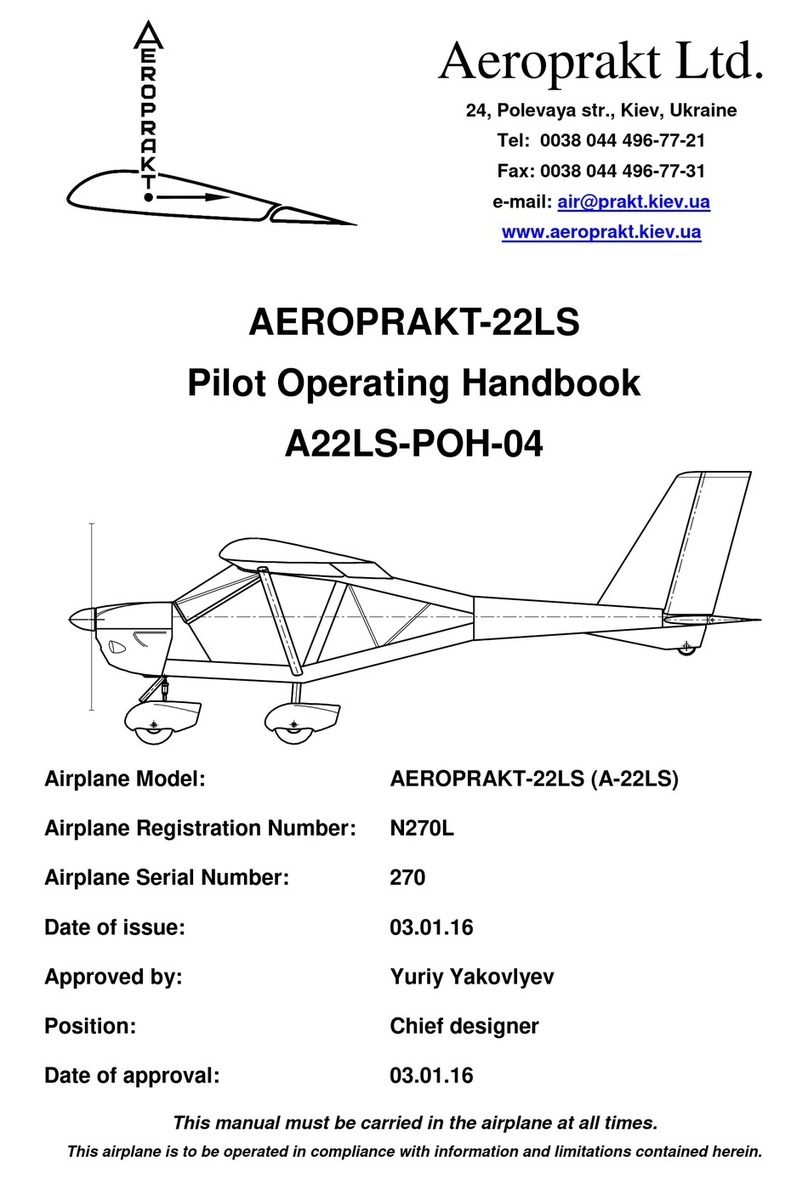
AEROPRAKT
AEROPRAKT A22LS-POH-04 Owner's manual

AEROPRAKT
AEROPRAKT A32-029-POH Owner's manual

AEROPRAKT
AEROPRAKT N226AM Owner's manual
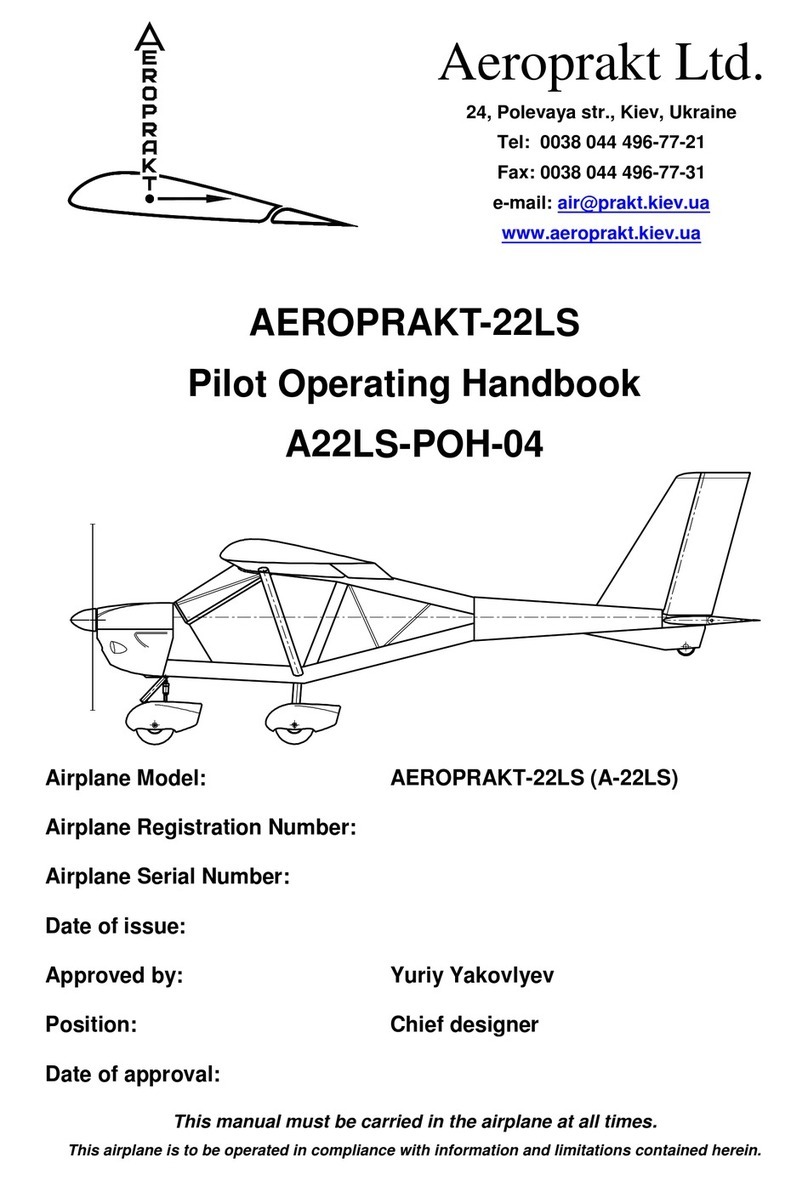
AEROPRAKT
AEROPRAKT A22LS Owner's manual

AEROPRAKT
AEROPRAKT 22LS Owner's manual
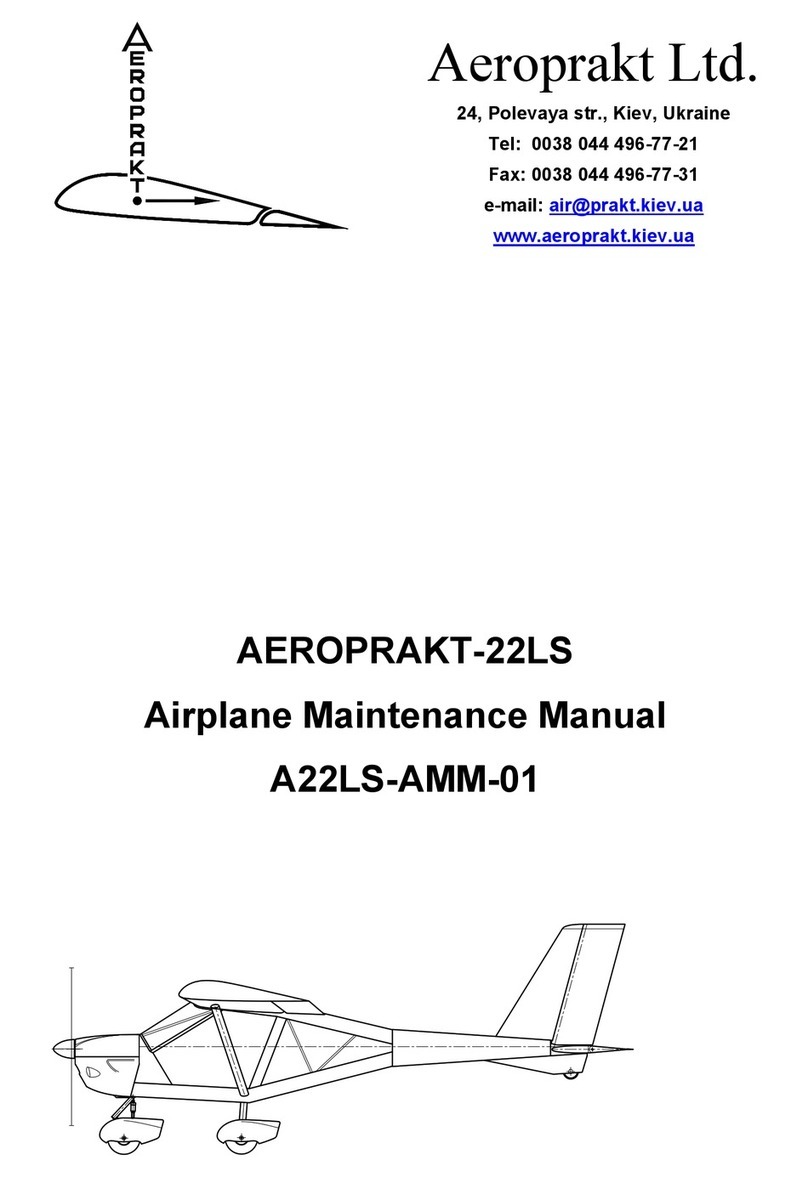
AEROPRAKT
AEROPRAKT A22LS User manual

AEROPRAKT
AEROPRAKT AEROPRAKT-22LS User manual
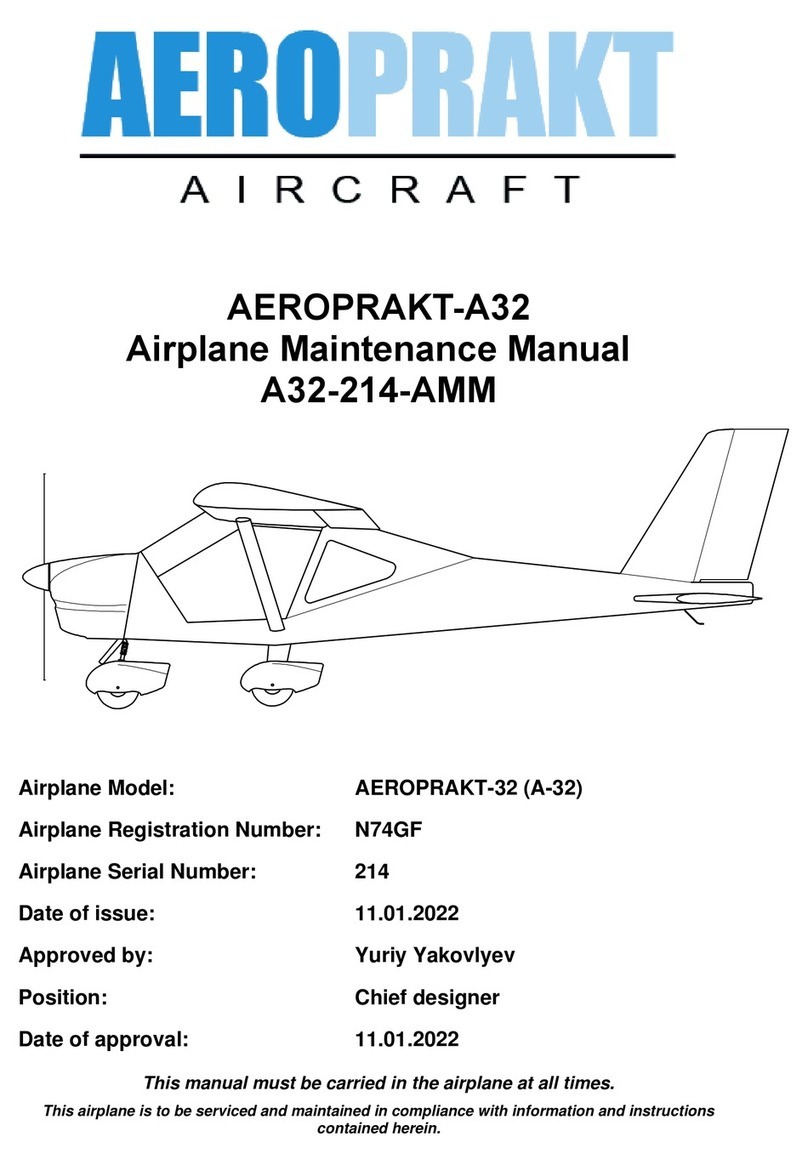
AEROPRAKT
AEROPRAKT A32 User manual
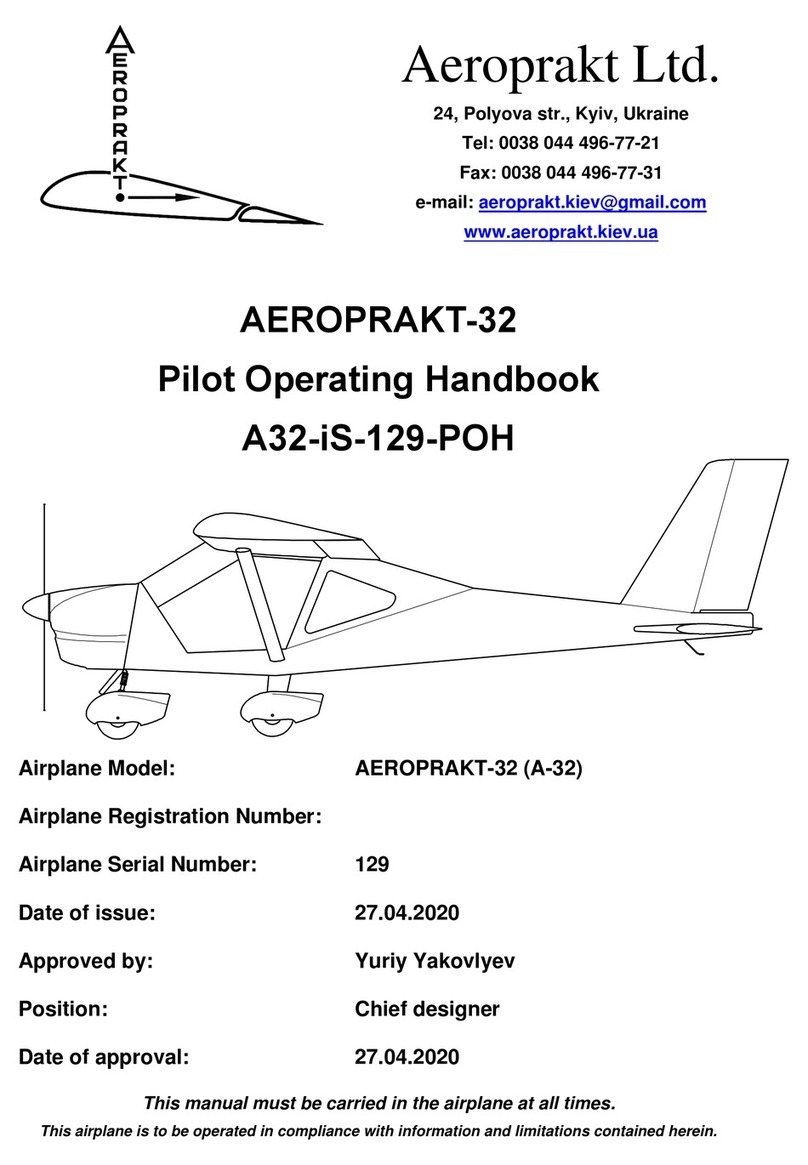
AEROPRAKT
AEROPRAKT A32-iS-129-POH Owner's manual
